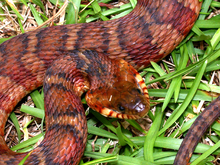Banded water snake
| Banded water snake | |
|---|---|

| |
| Scientific classification | |
| Kingdom: | Animalia |
| Phylum: | Chordata |
| Class: | Reptilia |
| Order: | Squamata |
| Suborder: | Serpentes |
| Family: | Colubridae |
| Genus: | Nerodia |
| Species: | N. fasciata
|
| Binomial name | |
| Nerodia fasciata (Linnaeus, 1766)
| |
| Synonyms | |
The banded water snake or southern water snake (Nerodia fasciata) is a species of mostly aquatic, nonvenomous, colubrid snakes endemic to the Midwest and Southeastern United States.
Geographic range[]
N. fasciata is natively found from Indiana, south to Louisiana, and east to Florida.
In 1992, its congener Nerodia sipedon (northern or common water snake) and it were found in three sites in California by the US Fish and Wildlife Service (USFWS). In 2009, more than 300 banded water snakes were caught in suburbs of Los Angeles by the Nerodia Working Group of USFWS. Then in May 2016, the species was found in the Colorado River basin near Yuma, Arizona. Further trapping did indeed catch large numbers of them, indicating that a thriving invasive population exists in that area.[5][6][7]
Description[]

Adults of the banded water snake measure from 61.0 to 107 cm (24.0 to 42.1 in) in total length, with a record size (in the Florida subspecies) of 158.8 cm (62.5 in) in total length.[8] In one study, the average body mass of adult banded water snakes was 464.3 g (16.38 oz).[9]
It is typically gray, greenish-gray, or brown in color, with dark crossbanding. Many specimens are so dark in color that their patterning is barely discernible. They have flat heads, and are fairly heavy-bodied. If irritated, they release a foul-smelling musk to deter predators.[citation needed]
Their appearance leads them to be frequently mistaken for other snakes with which they share a habitat, including the venomous cottonmouth.
Habitat[]
N. fasciata inhabits most freshwater environments such as lakes, marshes, ponds, and streams.[10]
Diet[]
It preys mainly on fish and frogs.[11] Using its vomeronasal organ, also called Jacobson's organ, the snake can detect parvalbumins in the cutaneous mucus of its prey.[4]
Reproduction[]
The species is ovoviviparous, giving birth to live young. The brood size varies from 9 to 50. Newborns are 200–240 mm (about 8.0–9.5 in) in total length.[12]
Subspecies[]
The three recognized subspecies of N. fasciata, including the nominotypical subspecies, are:[13]
- N. f. confluens (Blanchard, 1923)
- N. f. fasciata (Linnaeus, 1766)
- N. f. pictiventris (Cope, 1895) – Florida banded water snake
Taxonomy[]
Some sources consider N. clarkii compressicauda and N. clarkii taeniata to be subspecies of N. fasciata.[14] Also, some sources have considered Nerodia fasciata to be a subspecies of Nerodia sipedon.[3][12][15]
References[]
- ^ Hammerson, G.A. (2007). "Nerodia fasciata". IUCN Red List of Threatened Species. 2007: e.T62237A12583389. doi:10.2305/IUCN.UK.2007.RLTS.T62237A12583389.en. Retrieved 19 November 2021.
- ^ Boulenger, G.A. 1893. Catalogue of the Snakes in the British Museum (Natural History). Volume I., Containing the Families...Colubridæ Aglyphæ, part. Trustees of the British Museum (Natural History). (Taylor and Francis, Printers). London. xiii + 448 pp. + Plates I.- XXVIII. (Tropidonotus fasciatus, pp. 242–244.)
- ^ a b Stejneger, L., and T. Barbour. 1917. A Check List of North American Amphibians and Reptiles. Harvard University Press. Cambridge, Massachusetts. 125 pp. (Natrix sipedon fasciata, p. 96.)
- ^ a b Smargiassi, M. T.; Daghfous, G.; Leroy, B.; Legreneur, P.; Toubeau, G.; Bels, V.; Wattiez, R. (2012). Permyakov, Eugene A (ed.). "Chemical Basis of Prey Recognition in Thamnophiine Snakes: The Unexpected New Roles of Parvalbumins". PLOS ONE. 7 (6): e39560. Bibcode:2012PLoSO...739560S. doi:10.1371/journal.pone.0039560. PMC 3384659. PMID 22761824.
- ^ "Battling an invasion of watersnakes – US Fish & Wildlife Service – Pacific Southwest Region".
- ^ "California Nerodia Watch – iNaturalist".
- ^ "Florida Watersnake – Nerodia fasciata pictiventris".
- ^ [1]
- ^ [2][permanent dead link]
- ^ Conant, R. 1975. A Field Guide to Reptiles and Amphibians of Eastern and Central North America, Second Edition. Houghton Mifflin. Boston. xviii + 429 pp. ISBN 0-395-19977-8 (paperback). (Natrix fasciata fasciata, p. 146 + Plate 20 + Map 100.)
- ^ Conant, R., and W. Bridges. 1939. What Snake Is That? A Field Guide to the Snakes of the United States East of the Rocky Mountains. D. Appleton-Century. New York and London. Frontispiece map + viii + 163 pp. + Plates A-C, 1–32. (Natrix sipedon fasciata, p. 103 + Plate 18, Figure 53.)
- ^ a b Wright, A.H., and A.A. Wright. 1957. Handbook of Snakes of the United States and Canada. Comstock. Ithaca and London. 1,105 pp. (in 2 volumes) (Natrix sipedon fasciata, pp. 525–529, Figure 156.)
- ^ The Reptile Database. www.reptile-database.org.
- ^ ITIS (Integrated Taxonomic Information System). www.itis.gov.
- ^ Schmidt, K.P., and D.D. Davis. 1941. Field Book of Snakes of the United States and Canada. G.P. Putnam's Sons. New York. 365 pp. (Natrix sipedon fasciata, pp. 221–222, Figure 72. + Plate 24, Center, on p. 344.)
- Species Nerodia fasciata at The Reptile Database
External links[]
| Wikispecies has information related to Nerodia fasciata. |
| Wikimedia Commons has media related to Nerodia fasciata. |
- "Nerodia fasciata" at the Encyclopedia of Life
- California Nerodia Watch – iNaturalist
- Florida Watersnake – Nerodia fasciata pictiventris
Further reading[]
- Linnaeus, C. 1766. Systema naturæ per regna tria naturæ, secundum classes, ordines, genera, species, cum characteribus, diferentiis, synonymis, locis. Tomus I. Editio Duodecima, Reformata. L. Salvius. Stockholm. 532 pp. (Coluber fasciatus, p. 378.)
- IUCN Red List least concern species
- Nerodia
- Extant Pleistocene first appearances
- Reptiles described in 1766
- Taxa named by Carl Linnaeus
- Reptiles of the United States
- Fauna of the Southeastern United States

